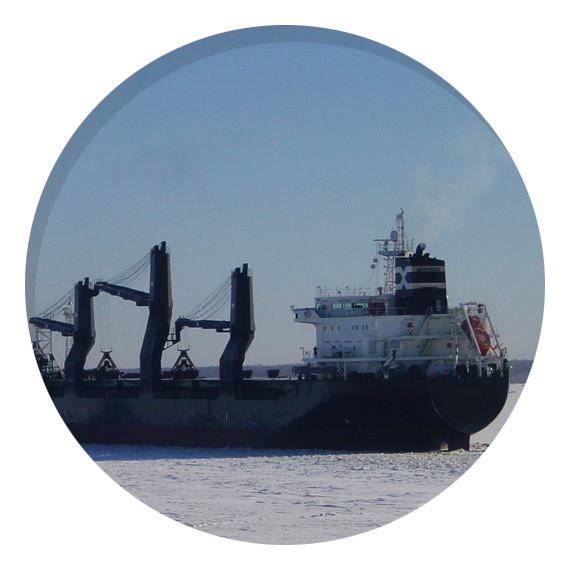Research on maritime transport emissions requires an overview

In addition to emissions restrictions, automation and smart sea traffic will alter the face of shipping over the next few years. Furthermore, new business opportunities in Arctic regions may also bring shipping service to the Arctic Ocean.
Emissions restrictions for all bodies of water in the world
Reducing the airborne pollution caused by maritime transport has long been an objective. The International Maritime Organization (IMO) is planning for significant sulphur restrictions for ship fuels. Global reductions are intended to enter into force by no later than 2025. In the Baltic and North Sea, where a majority of Finland's ships sail, sulphur limits have been more stringent than in other maritime areas for several years already.
Indeed, the Finnish Meteorological Institute is currently running several projects related to maritime transport emissions."It's vital that we first gain a comprehensive knowledge of shipping emissions, so that we can assess their health and environmental impacts as well as make plans for reducing and restricting emissions," explains Jukka-Pekka Jalkanen, Senior Researcher at the Finnish Meteorological Institute.
Emissions from ship fuels under investigation
Due to the use of high-sulphur fuels, maritime transport has been a significant source of air pollution. Emissions restrictions have led to the development of various fuels and emission abatement technologies. "There are excellent opportunities for reducing maritime transport emissions. Technical solutions for reducing both air pollution and greenhouse gas emissions are already available, like liquid natural gas (LNG), but they still require additional research. For example, sulphur scrubbers have been used on land-based applications, like power plants, for decades but marine scrubbers have to be significantly smaller than those. Additionally, scrubber produces waste sludge which cannot be released to the sea." notes Jalkanen.
Another example is marine fuels. Traditionally, ships have used low-grade, heavy fuel oil. Heavy fuel oil can be replaced with LNG on new vessels, thus reducing sulphur emissions. "You have to keep in mind that, even though LNG is seen as the fuel of the future right now, the problems associated with climate change might be exacerbated if gaseous fuels are released to the atmosphere. Liquefied natural gas is methane, which is a far more potent greenhouse gas than carbon dioxide. In the atmosphere, methane will warm the climate 25 times more effectively than carbon dioxide. "Therefore, some of the environmental benefit offered by new vessels would be reduced by the accidental methane emissions, while the aerosols emitted previously by maritime transport served to cool the climate. "It should be kept in mind that the service life of ships is long--approximately 30 years--so the choices made now will have a long-term impact. In the long run, we should be developing, in particular, energy efficiency and alternatives for fossil fuels.
Traffic in Arctic regions growing
Particulates emitted by ships are also linked to climate change. "A major concern in Arctic regions is black carbon, or soot, which accelerates climate change by reducing the reflection of sunlight from the surface of the ice back out into space," says Senior Research Scientist, Hilkka Timonen. An increase in Arctic maritime traffic and its emissions are a growing problem in the Arctic region. Black carbon emissions are relatively short-lived, which means that their climate impact is local in nature. It is concerning that the black carbon emissions of maritime transport in the Arctic region is predicted to double by 2050.
The ongoing SEA-EFFECTS BC project is investigating a measurement technology specifically intended for black carbon emissions and emissions monitoring performed directly on-board vessels. In the project, special attention is given to measurement methods in order to ensure that they produce reliable, comparable data in shipping conditions, using different types of fuels and post-processing technologies. "Different fuel emissions are not only affected by the fuel itself, but also how the engines are run. For example, we know that small changes in engine operation can significantly alter the composition of emissions," explains Timonen.
Measurement and modelling produce data to support decision-making
Although many shipping lines have already switched to more environmentally-friendly fuels, there is still lack of data on the overall impact of these solutions. The Envisum project is developing indicators and models for the assessment of shipping emissions, their environmental and health impacts and emission reduction methods. The purpose is to compare various options for emission reduction and assess their pros and cons from a variety of viewpoints. One way to gain a comprehensive view is the STEAM model developed by the Finnish Meteorological Institute. The model takes advantage of automatic transponder signals from ships. The information available on ships combined with other research data can be used to calculate the energy consumption, emissions and ultimately, when combined with atmospheric and bio-geochemical models, the impacts on humans and the environment.
The Finnish Meteorological Institute is also involved in the SHEBA project, which extends our modelling capabilities to water emissions. Previously, the focus of attention has been only on atmospheric emissions, like carbon dioxide, nitrogen and sulphur oxides, carbon monoxide and particulates. "Up until now, we've focused primarily on the substances found in the airborne emissions produced by ships, but other emissions will soon be included, such as bilge, waste and ballast water. In addition to this, also the noise generated by ships and its impact on marine life will be investigated in detail.
Started a few years ago in Utö, continuous measurements focusing on ship emissions also provide us with a new way for us to gather nearly real-time measurement data on the state of the Baltic Sea. The Utö Atmospheric and Marine Research Station has a comprehensive range of equipment, some of which are completely new and many being permanently installed in the sea for the first time in Finland. The basic idea for Utö is for a comprehensive approach, which gives an overall picture of the state of the sea and the lower atmosphere.
"A comprehensive examination is also extremely important right now, when the maritime sector is undergoing massive change," concludes Jalkanen.
